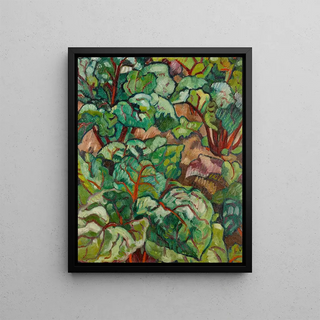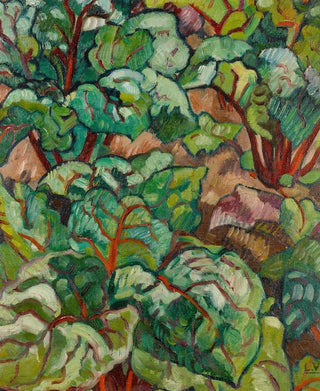Art print | Green plants - Louis Valtat


View from behind

Frame (optional)
Reproduction of Green Plants - Louis Valtat – Captivating Introduction
The artwork "Green Plants" by Louis Valtat is part of a period when Impressionism evolved towards bolder forms and more vibrant colors. This painting, with its brilliance and chromatic richness, invites a sensory immersion into the heart of lush nature. The leaves, with their varied shades of green, seem to vibrate under the light, creating a harmonious dialogue between the artist and his subject. The depiction of nature, far from being a simple backdrop, becomes a true protagonist, revealing Valtat's passion for botany and his desire to capture the very essence of plant life.
Style and uniqueness of the artwork
Valtat's style is distinguished by a bold and innovative approach to color and form. In "Green Plants," he uses a vibrant palette that transcends realism to evoke an almost dreamlike atmosphere. The brushstrokes, both delicate and energetic, inject dynamism into the composition, giving the impression that the plants are in motion, vibrant with life. The artist skillfully plays with light, creating shadows and reflections that add depth to the overall piece. This work is a perfect example of how Valtat manages to marry the rigor of botanical observation with a personal and poetic interpretation, making each leaf and stem an expression of his own artistic universe.
The artist and his influence
Louis Valtat, an emblematic figure of the Fauvist movement, established himself through his unique style and innovative vision. Influenced by masters such as Monet and Van Gogh, he nonetheless developed a distinct identity, marked by a daring use of colors and a constant search for light. His work, although deeply rooted in the Impressionist tradition, opens up to experiments that prefigure modern trends. Valtat was also a key player in promoting modern art in France, participating in numerous exhibitions and collaborating with other artists of his time. His impact on the art scene was significant, inspiring generations of artists to explore new creative paths.
A decoration

Matte finish

View from behind

Frame (optional)
Reproduction of Green Plants - Louis Valtat – Captivating Introduction
The artwork "Green Plants" by Louis Valtat is part of a period when Impressionism evolved towards bolder forms and more vibrant colors. This painting, with its brilliance and chromatic richness, invites a sensory immersion into the heart of lush nature. The leaves, with their varied shades of green, seem to vibrate under the light, creating a harmonious dialogue between the artist and his subject. The depiction of nature, far from being a simple backdrop, becomes a true protagonist, revealing Valtat's passion for botany and his desire to capture the very essence of plant life.
Style and uniqueness of the artwork
Valtat's style is distinguished by a bold and innovative approach to color and form. In "Green Plants," he uses a vibrant palette that transcends realism to evoke an almost dreamlike atmosphere. The brushstrokes, both delicate and energetic, inject dynamism into the composition, giving the impression that the plants are in motion, vibrant with life. The artist skillfully plays with light, creating shadows and reflections that add depth to the overall piece. This work is a perfect example of how Valtat manages to marry the rigor of botanical observation with a personal and poetic interpretation, making each leaf and stem an expression of his own artistic universe.
The artist and his influence
Louis Valtat, an emblematic figure of the Fauvist movement, established himself through his unique style and innovative vision. Influenced by masters such as Monet and Van Gogh, he nonetheless developed a distinct identity, marked by a daring use of colors and a constant search for light. His work, although deeply rooted in the Impressionist tradition, opens up to experiments that prefigure modern trends. Valtat was also a key player in promoting modern art in France, participating in numerous exhibitions and collaborating with other artists of his time. His impact on the art scene was significant, inspiring generations of artists to explore new creative paths.
A decoration






